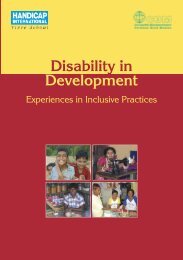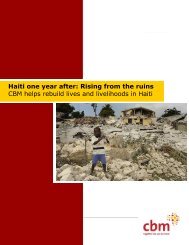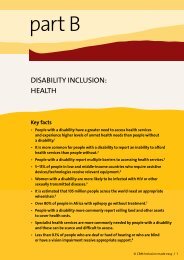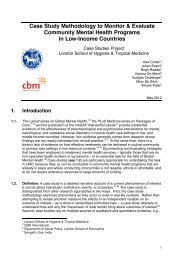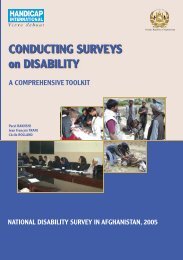Vision 2020 - World Health Organization
Vision 2020 - World Health Organization
Vision 2020 - World Health Organization
Create successful ePaper yourself
Turn your PDF publications into a flip-book with our unique Google optimized e-Paper software.
VISION <strong>2020</strong> GLOBAL INITIATIVE FOR THE ELIMINATION OF AVOIDABLE BLINDNESS: ACTION PLAN 2006–2011<br />
Links to other indicators<br />
Underlying definition<br />
Measurement methods<br />
Limitations<br />
Frequency<br />
Demographic; disease-specifi c prevalence of blindness<br />
From African Programme for Onchocerciasis Control, Onchocerciasis<br />
Elimination Programme in the Americas and the former Onchocerciasis<br />
Control Programme for special intervention zones<br />
Data not available from certain areas (e.g. those in confl ict)<br />
Annual<br />
Recommended: Incidence of blindness from onchocerciasis (the target is none)<br />
1.8 Indicators for control of age-related macular<br />
degeneration<br />
• prevalence of blindness and visual impairment due to age-related macular degeneration (mostly at national level, e.g.<br />
from population-based epidemiological survey); and recommended, coverage of patients with age-related macular<br />
degeneration with low-vision services<br />
1.9 Indicators for control of diabetic retinopathy<br />
• prevalence of blindness and visual impairment due to diabetic retinopathy;<br />
• population per standard eye centre for management of diabetic retinopathy with competent retinal specialists,<br />
functional retinal laser and standard diagnostic equipment (recommended at national level);<br />
• population per tertiary eye centre providing comprehensive medical and surgical posterior segment services (recommended<br />
at national level); and<br />
• recommended, coverage by services (e.g. percentage of diabetic patients who undergo annual eye examination,<br />
percentage of patients with diabetic retinopathy who are treated by retinal laser)<br />
1.10 Indicators for control of glaucoma<br />
• prevalence of blindness and visual impairment due to glaucoma; and<br />
• number of countries in which prevention of visual impairment due to glaucoma is adequately addressed in the national<br />
VISION <strong>2020</strong> plan for prevention of blindness<br />
2. Indicators for human resource development<br />
Ophthalmologists<br />
Recommended: cataract surgeons, optometrists, refractionists, ophthalmic nurses and assistants, personnel trained in<br />
childhood eye care and management (professions must be clearly defi ned, collection at subnational and national levels)<br />
Level of collection<br />
Level of collation<br />
Brief definition<br />
Unit of measurement<br />
Purpose<br />
Links to other indicators<br />
Underlying definition<br />
National (disaggregated in large countries)<br />
Regional/global<br />
Number per million population<br />
Absolute number<br />
To assess availability of services<br />
Performance indicators, cataract surgical rate<br />
Cadre as defi ned in country<br />
78






